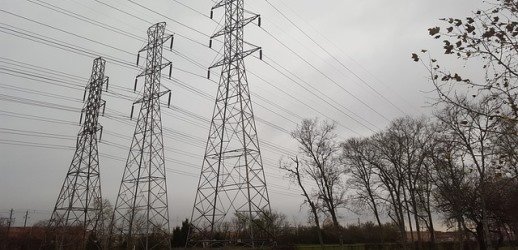VPU ETF For Dividends From Utility Stocks
Let’s take a close look at the VPU ETF today.
VPU is the stock ticker symbol for the Vanguard Utilities exchange-traded fund (ETF). If you do not desire to invest in individual utility stocks, the VPU ETF is a great alternative.
Also, before I finish the VPU ETF review, I want to show you how investing in VPU can turn pennies into thousands of dollars.
And I will do my best to answer a few important questions. Such as:
- What is the Vanguard Utilities ETF?
- Is VPU stock a good buy?
- What is the best utility ETF?
I will get to those questions and many more in a moment. But first, a brief overview.

Disclosure: At no cost to you, I may get commissions for purchases made through links in this post.
VPU ETF Review: Key Takeaways
1. VPU is an exchange-traded fund (ETF) made up of stocks from large, mid-size, and small US companies within the utility sector.
2. The ETF has dozens of dividend stock holdings. The 10 largest holdings comprise a large percentage of the fund’s total investments.
3. The fund has consistently provided current income from dividends, annual growth from those dividends, and share price appreciation.
4. Being a sector-focused ETF, it is subject to investment concentration risk. So, it is best suited for an otherwise diversified investment portfolio.
Next, a little background information. About ETFs in general and then we will fully explore VPU.
What Is An ETF?
According to Investopedia, an exchange-traded fund (ETF) is a collection of securities, such as stocks. ETFs track an underlying index of stocks to duplicate the index’s investment performance.
An ETF is called an exchange-traded fund since it is traded on an exchange, just like an individual stock. The price of an ETF’s shares will change throughout the trading day as the shares are bought and sold on the market.
In contrast to exchange-traded funds, traditional open-end mutual funds trade just once per day. Shares are transacted after the stock market closes.
What Is A Utility ETF?
So, if you are not interested in selecting and buying individual stocks. Then, with 1 small purchase, you can own a diverse portfolio of stocks.
In this case, VPU holds dozens of stocks from the US utility sector for instant diversification from a single purchase. Income from dividends and low expenses are additional advantages to investing in utility stocks through an ETF like VPU.
Next, let’s learn more about these specific topics by digging into the VPU ETF review.
What is the Vanguard Utilities ETF?
As our ETF definition mentions, ETFs track an underlying index. According to Vanguard, the VPU ETF seeks to track the performance of the MSCI US Investable Market Utilities Index.
The index comprises stocks from large, mid-size, and small US companies within the utility sector. Furthermore, the utility sector includes electric, gas, and water utility companies.
Finally, the sector also includes
- Independent power producers
- Energy traders
- Companies that generate and distribute electricity from renewable sources

VPU Holdings
VPU has many individual dividend stock holdings from the utility sector. Therefore, you get all those utility company dividend stocks with one purchase.
The 10 largest holdings comprise a large percentage of the fund. So, by looking at some of the largest positions, we can get a pretty good feel for VPU overall.
I also like to look at ETF dividend portfolios for investment tips. Searching for possible dividend stocks I might like to own.
Here are some of VPU ETF’s holdings. Note that these holdings are as of the publication date of this article. Please check Vanguard’s website for changes and up-to-date information.
Table 1: Select VPU Utility Stock Holdings
| Utility Stock |
| NextEra |
| Dominion Energy (D) |
| Duke |
| Southern Co. |
| AEP stock |
| Exelon |
| Sempra Energy |
| Xcel Energy |
| Wisconsin Energy (WEC) |
| Eversource Energy |
I have invested in utility stocks for a long time. And earn dividend income from some of the best stocks in this sector.
But, I do not currently own the VPU ETF. However, as indicated by the blue links in the table, I own several stocks that VPU holds.
Each of these utility stocks is a member of my dividend stock model portfolio. And each is linked to my most recent dividend stock review of the company stock.
VPU ETF Dividend & Dividend Yield
VPU’s dividend payout usually translates to a dividend yield ranging from 2.5%-4% depending on fluctuations in the price of the shares.
If you are a regular reader, you know I prefer dividend yields in the 3-5% range. So, the VPU dividend yield fits in my “sweet spot”.
But perhaps you are interested in higher dividend yields? I don’t know. That’s for you to decide.
VPU ETF Dividend History
Let’s discuss VPU dividend history now. It may provide insight into the consistency of cash flow we can expect by investing in the fund.
First, take note that VPU dividends are paid quarterly. However, each quarterly payout is different. The payout depends on which companies in the fund are paying their dividends and when.
If you require monthly dividends or the same cash payout each quarter, be aware that the VPU ETF does not provide either.
Based on my review, it is interesting that the VPU dividend payment continued to increase in 2008 and 2009. Why? This was during the financial crisis, global recession, and bear market in stocks that those situations created.
Many companies were forced to reduce their dividends to conserve cash during that time. But, as a whole, the US utility sector could power on through. VPU offered shareholders a rising passive income stream from dividends during the worst economic times.
It will be interesting to see what happens with the VPU ETF dividends moving forward.
VPU ETF Dividend Growth Rate
Now let’s discuss the annual VPU dividend payments and see what the growth rates look like. With a moderate dividend yield, I certainly want to see some growth.
What I see looking at the VPU dividend growth rate is consistency. This makes sense because we are talking about a portfolio of some of the most consistent dividend stocks you can find.
During the fund’s history, we experienced a deep recession during 2008-2009. Then, a robust economic expansion in more recent years. More recently, another short recession was caused by the pandemic. And now, higher interest rates.
Regardless, dividend growth has remained pretty much the same. Hovering close to 5% over the long term.
VPU dividend growth varies, better in some years and worse in others. But I think we can count on anywhere between 3-6% annually over the long term.
VPU ETF Performance Based On Total Return

According to Vanguard’s website, the VPU ETF opened for business in January 2004. As of the date of this article, VPU has averaged solid per year total return since its inception.
During its history, the VPU ETF has endured bear markets. The first bear was in 2008-2009. And next, the short bear market of 2020. Others will surely follow.
And what can we learn from this? No matter when you invest in stocks, invest long term, stay diversified and your results will likely be okay.
Furthermore, utility stocks pay plenty of cash in the form of dividends even when share prices go down.
Utility stocks continue through the ups and downs of various market cycles. Not a bad investment option, in my opinion.
Turning Pennies Into Thousands With The VPU ETF

Now, let’s use the power of compounding returns to turn pennies into thousands of dollars.
The VPU ETF has been in existence for many years. So, let’s assume you invest $150 into the VPU ETF at the end of each quarter year.
That is $150 during March, June, September, and December doing so for 16 years as an example. There are about 90 days each quarter, so that’s just $1.67 per day. Okay, so a little more than a dollar a day.
At a little more than 9% hypothetical annual return, you would have about $12,600 at the end of that investment period. And that $12,600 would be paying you almost $500 in cash dividends each year.
Most importantly, this investment performance comes from stable, steady stocks that provide services we use no matter what is going on in the world.
Electricity, water, and natural gas are not going out of style anytime soon.
Of course, past performance does not guarantee future results. So, understand there are risks involved with investing in stocks. After all, it’s your money, not mine.
VPU ETF Expense Ratio
Here is an area where ETFs and Vanguard specifically do very well. That is the area of low costs.
Low investment costs help your pennies grow into thousands much more quickly. Because you keep more of the recurring dividend payments that you earn.
The VPU ETF expense ratio is a small .1% at the time of publication. In other words, if you have a balance of $100 in VPU for the year, Vanguard will charge you only 10 cents.
What about when your VPU stock is worth $12,600? Then, you will be paying just $12.60 per year.
So, that is the VPU ETF expense ratio. However, there is 1 other investment cost you should consider. That is trading commissions. Let’s discuss this.
Can You Trade Vanguard ETFs Commission Free?
The commission on the trade is free if you buy VPU stock using a Vanguard brokerage account. On the other hand, some brokerage firms still charge trading commissions.
However, there is no reason to pay commissions to trade stocks or ETFs. Those days are gone.
As I said, you need a brokerage account to buy VPU stock and receive the VPU dividends. I have a brokerage account with Webull.
Opening a Webull account is super easy. And Webull has a fast and easy-to-use app.
Or, click here if you are ready to sign up for a Webull account.
Sign up and fund your account and Webull will give you free stock! I received free stock when I signed up too.
Looking for a different type of financial service provider. Finally ready to open that IRA account to save and invest for retirement. If so, there are plenty of options.
Before we wrap up, let’s address VPU’s valuation. And answer a few frequently asked questions.
VPU Stock Valuation
I will use a dividend growth formula to judge the VPU stock value. The single-stage dividend discount model considers several factors I have discussed thus far.
- The current annual dividend payment
- Projected dividend growth
And one assumption that has not yet been discussed. That is my desired annual return on investment.
Using these assumptions, the dividend discount model tells us VPU shares are overvalued as of the date of this article.

Is VPU A Good Buy?
At the recent VPU stock price, the VPU dividend discount model indicates that VPU stock is overvalued at recent prices.
But that misses the point, in my opinion. Our example of turning pennies into thousands suggests investing small amounts regularly is a reliable way to implement a dividend investing strategy.
No matter what the VPU stock price might be, investing small amounts at regular intervals is a good way to approach dividend investing. This strategy is often referred to as dollar-cost averaging.
Especially with good dividends stocks. And dividend-paying ETFs like VPU.
What Is The Minimum Amount Required To Invest In The VPU ETF?
So, if investing small amounts at regular intervals is a good dividend investing strategy. Then, what is the minimum amount required for an investment in the VPU ETF?
Well, an investor has to buy at least 1 share in an ETF to get started investing. This means you can start investing in VPU stock without much money.
And if you open a Webull brokerage account to buy that share for a limited time, Webull will give you free stock.
What Is The Best Utility ETF?
The Vanguard Utilities ETF is not the only one of its kind. There are other utility stock ETF options. Here are just a few that I am familiar with.
- Utilities Select Sector SPDR (XLU)
- Fidelity MSCI Utilities Index (FUTY)
- iShares US Utilities (IDU)
Are Vanguard ETFs Good?
So, if there are other utility ETF options, does Vanguard have good ETFs?
To me, ETFs are mostly a commodity. They are all a little different but mainly the same.
In general, I think Vanguard ETFs are good. Where Vanguard separates itself is with low costs. Vanguard is usually one of the lowest-cost options when comparing ETFs.
Individual stocks or funds? A few words on that debate…
Utility ETFs vs. Individual stocks
The main advantage of ETFs versus individual dividend stocks is the instant diversification an investor can have with a single purchase.
Furthermore, there is no need to spend time researching and selecting individual dividend stocks for your investments.
Finally, ETFs make investing in stocks easy.
On the other hand, I prefer picking individual stocks. And I use the Simply Investing Report to help guide my decisions.
If you prefer selecting your dividend stocks too, read my full review of the Simply Investing report here.
Or find out more direct from Simply Investing.
You might wonder why I prefer to select and buy individual dividend stocks. The primary disadvantage of dividend stock ETFs is that the ETF will contain some stocks that may be poor investments.
With dozens of stocks in an ETF like VPU, not all are great companies. Nor will every stock in an ETF be a high-performing individual investment.
So, you must take the good with the not-so-good when investing in ETFs.
Is The VPU ETF Right For You?
The utility sector is considered to be defensive. Therefore, utilities are often desirable in a down market cycle. They also offer a relatively stable income and share price growth.
But utility ETFs may not be right for every investor. It is a concentrated fund that focuses on a single sector. So, it is best not to allocate all your portfolio assets to just one sector fund like the VPU ETF.
Diversification is critical if you are retired and relying on investments for income.
VPU ETF Fact Sheet & Summary
Here is a quick fact sheet and summary from this article about the Vanguard Utilities ETF – VPU:
I think the VPU ETF can be a part of a diversified investment portfolio. A few summary points to leave you with about the VPU ETF.
- Moderate VPU dividend yield of more than
- Consistent VPU dividend growth
- Diversification among dozens of stocks from the US utility sector
- VPU is low cost and can be bought and sold commission-free
- The VPU ETF requires only a small initial investment
If You Liked This Vanguard Utilities ETF Review, You Might Enjoy…
- VYM review – Vanguard high dividend yield ETF
- VIG review – Vanguard dividend appreciation ETF
- VYMI review – Vanguard international high dividend ETF
My Favorite Dividend Investing Resources
- The Webull app for fast, free stock trading
- The Simply Investing Report for dividend stock analysis & recommendations
- Manage your total financial picture for free using Personal Capital
Author Bio: Tom Scott founded the consulting and coaching firm Dividends Diversify, LLC. He leverages his expertise and decades of experience in goal setting, relocation assistance, and investing for long-term wealth to help clients reach their full potential.



Hi Tom,
Great review. I own VPU and regularly add to it, as a long term holding. I like the stability and steady dividends it adds to my portfolio. Plus, I believe in holding utilities, since their product will always be in demand.
The long-term transition to electric cars gives me even more reason to be a long-term bull.
Cheers,
Miguel
Appreciate an owner’s perspective, Miguel. I believe VPU will serve you (and most investors) well in the long run. Tom
I don’t have VPU but this is a great option for those who want to invest in utilities but want a bit more diversification. Great review!
Thanks, GYM. Totally agree. The Vanguard Utilities Fund (VPU) is a good option for the reasons you mention. If I wasn’t already heavily weighted in the top 10 holdings, I would be a buyer. Tom